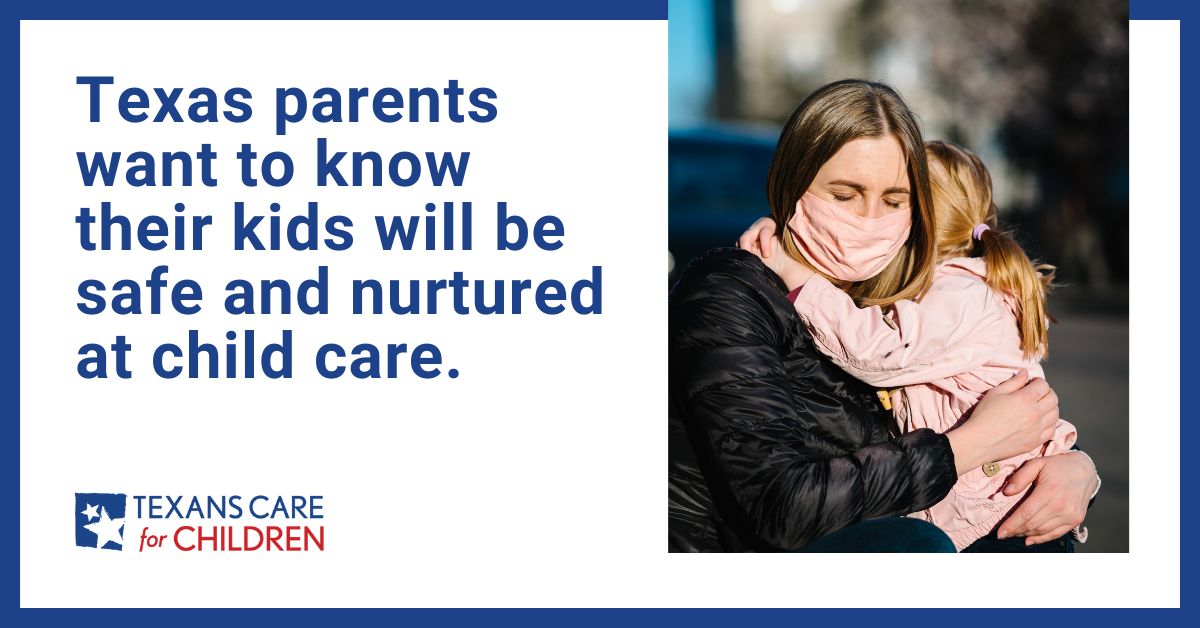When parents hug their children goodbye at child care and then head to work, they want to know that their little ones will be safe. They trust that the teacher will notice if their baby quietly puts a choking hazard in her mouth or their toddler begins to wander away.

During these critical early years of brain development, parents also want to know that their children are getting the attention they need to build up the social, emotional, and learning tools they will later need in school. They trust that the teacher will have the time to comfort their son if he’s having a hard day or give their daughter plenty of fun, engaging activities, like listening to a story or fingerpainting or playing outside.
To provide this kind of quality child care experience for their kids, parents are counting on state policymakers to be a strong partner. Finding affordable, nearby child care with an opening is often extremely difficult, particularly for families who have a tight budget or live in “child care deserts.” When busy, stressed out parents finally find a viable child care option, they trust that Texas leaders have put some basic rules in place to protect their kids.
Unfortunately, for many kids and parents in Texas, this is not the reality. In fact, DFPS — the state agency previously in charge of keeping child care safe — issued the following warning in 2010.
“DFPS “does not believe the current standards for group size…or ratios adequately protect the health and safety of children in some age ranges.”
In fact, when the Austin American-Statesman conducted an investigation into children dying in Texas child care amid lax state oversight, one of the culprits they identified was the high number of little kids that can be left in the care of a single child care teacher. The yearlong investigation revealed that hundreds of children have been seriously injured and nearly 90 died as a result of abuse or neglect since 2007.
TAKE ACTION: URGE TEXAS OFFICIALS TO PROTECT KIDS IN CHILD CARE!
Just how bad are the current Texas rules on child care ratios and group sizes?
Texas allows a single child care teacher to be responsible for 11 two-year-olds! That’s tied for worst in the nation, far off from the recommendation of the American Academy of Pediatrics (no more than 3 two-year-olds per caregiver) and the NAEYC recommendation (no more than 6 two-year-olds).
The minimum standard for group sizes is also troubling. For example, if a group of infants is between 12-17 months, two caregivers are authorized to supervise 13 infants at once, also far off from best practice recommendations, which recommend no more than 8 infants at once per class.
And it isn’t just the infants and toddlers. Under Texas standards, as many as 15 three-year-olds might be stuck competing for the attention of a single, overwhelmed teacher. These and other Texas child care ratio standards fall far short of national best practices and nearly all other states.
Under these rules, a teacher may walk into this classroom in the morning with big plans to read books with the children, play counting games, or supervise engaging art projects. But faced with 11 two-year-olds and no help, inevitably she’ll spend most of the day just taking them to the bathroom or changing tables and trying to prevent too many shoving matches.
Yet, there is reason to be optimistic — and a chance right now to make things better.
State policymakers have shown greater interest in improving child care, passing a suite of bipartisan bills during the recent legislative session.
The limits on teacher-child ratios in child care are established by the state agency, not the Legislature. It’s a process the state undertakes at least every six years. And now it’s time to do it again.
This summer, the Child Care Regulation (CCR) officials in the state’s Health and Human Services Commission (HHSC) are collecting public input on updating the state’s child care standards, including but not limited to teacher-child ratios. We recently testified to CCR about the need to improve ratios and make other changes to child care standards.
We encourage Texans to submit their own comments to CCR officials calling for improved teacher-child ratios in child care. It’s easy. Just send a quick email to msc@hhsc.state.tx.us — or contact state officials through our online Action Center:
TAKE ACTION: URGE TEXAS OFFICIALS TO PROTECT KIDS IN CHILD CARE!
We recommend submitting your comments by August 16th. If you have any questions, let us know. You can contact me at dfeigen@txchildren.org.
Thank you for supporting Texas kids!



